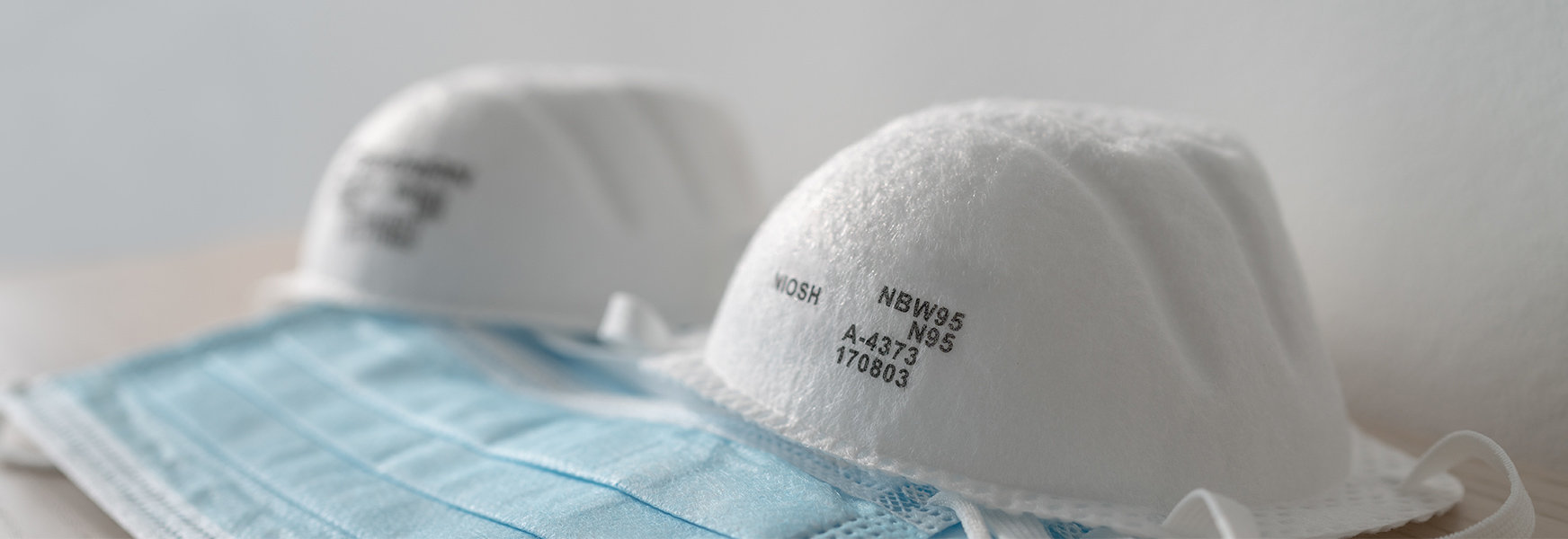N95 Respirators in the Time of COVID-19; Let’s Talk Fundamentals.

In this unprecedented time, countries around the world, including the U.S., are dealing with thousands of COVID-19 patients. Our healthcare system is being stressed and there is a shortage of personal protective equipment (PPE), including N95 respirators – a primary defense against this virus. So, what does N95 mean?
Air purifying respirators using particulate filters are used for protection against aerosols in liquid or solid form such as fumes, mists, solid particles, bioaerosols, smoke and droplets. Title 42 CFR Part 84 – Approval Respiratory Protection Devices, describes several filter classes:
- N = filters restricted to use in workplaces free of oil aerosols – not resistant to oil2.
- R = filters that are somewhat resistant to oil2.
- P = filters that are strongly resistant to oil2.
Additionally, the filters can be classified based on collection efficiency: 95, 99 and 100. In this case, N95’s are air purifying filters to be used against nonoil aerosols with a collection efficiency of at least 95 percent. In the same manner, filters classified or rated as 99 and 100 have higher collection efficiencies than filters classified or rated as 95.
It should be noted that tests used to determine filters’ efficiency use the most penetrating particle size; therefore, it is likely that the actual filter efficiency may be greater than the one stated in its approval1, 2. With that said, what is an N95 respirator? Air purifying respirators can be classified in three major categories:
- Filtering facepieces,
- Elastomeric facepiece respirators and,
- Powered air purifying respirators (PAPR).
Elastomeric facepiece respirators (half-face or full-face respirators) can be cleaned for reuse and its filters can be changed as needed. Powered air-purifying respirators (PAPRs) use a blower to move breathing air through its filter. It is also meant to be reused1, 3. This is not true with filtering facepieces because most of the facepiece is composed of the filtering medium3. Therefore, N95 respirators are filtering facepieces made of a filter with N95 classification. These are also known as N95 respirators, N95 facepieces, or simply N95’s. The shortage of N95 respirators during the COVID-19 pandemic is largely due to the disposable nature of the respirator and the high number of infected persons.
In 2018, the CDC’s National Institute for Occupational Safety and Health (NIOSH) recognized the possibility of N95 respirator depletion within healthcare settings during a pandemic. As a result, NIOSH developed recommended guidance for extended use and limited reuse of N95 filtering facepiece respirators4. Extended use is defined as using the same respirator for repeated encounters with several patients without removing it. This is the recommended option for conserving respirators rather than its limited reuse. Limited reuse can be defined as using the same N95 respirators for repeated encounters with several patients but removing and storing it after each encounter. This practice increases the potential of cross-contamination between reuses. Additionally, N95 respirators should not be shared among workers4. Regardless of whether the respirators are reused on a limited basis or used for extended periods of time, it should be discarded if:
- The respirator is used during aerosol generating procedures,
- It becomes contaminated with bodily fluids from patients (consider using a cleanable face shield over the respirator to avoid these issues),
- If the worker is in contact with a patient with an infectious disease requiring new equipment for every contact,
- If the respirator becomes damaged or,
- If it becomes hard to breath4.
The effectiveness of the N95 respirator relies on having a tight seal with the worker’s face1, 2, 3, therefore it is very important to conduct seal checks as specified by the respirator’s manufacturer. Healthcare workers should clean their hands with soap or sanitizer before and after adjusting the respirator and ensure that it does not become damaged or deformed between uses. Any employee required to use a respirator, including in healthcare facilities, should be included in a respiratory protection program1. If N95 respirators are used in other industries, why not use them in the healthcare settings?
Standard N95 respirators and surgical N95 respirators (also known as healthcare respirators or healthcare N95 – and not to be confused with surgical masks) have the same collection efficiency as explained previously. The U.S. Food and Drug Administration (FDA) requires that surgical N95 respirators meet established fluid penetration resistance, biocompatibility and flammability levels in order to be considered a medical device5. Due to the great demand for N95’s within the healthcare industry during this pandemic, the FDA granted the request for an emergency use authorization (EUA) to allow certain N95 respirators, typically found in the industrial settings, to be used in healthcare. A list of the N95 respirators included in the emergency use authorization can be found here. The authorization also included those respirators in good condition that have passed their recommended shelf life- that list can be found here. It should be noted that N95 respirators (whether FDA approved or not), provide the same level of protection when used in accordance with manufacturers’ recommendations and surgical masks are not considered air purifying respirators6, 7.
I encourage you to review the document published by NIOSH and the manufacturers’ website for respirator use guidelines and any updated recommendations about the maximum uses for the specific model of respirator used at your facility. I also encourage you to review the risks associated with extended use and limited reuse of N95 respirators contained in the recommended guidance published by NIOSH. This can help you the determine the best strategy to keep your employees protected and lower their risk of infection.
References:
- Anna, D. H. (Ed.) (2011). The occupational environment: its evaluation, control and management, 3rd Edition. Fairfax, VA: American Industrial Hygiene Association.
- National Institute for Occupational Safety and Health (2018) A Guide to Air-Purifying Respirators. By Cichowicz J, Coffey C, Fries M. Pittsburgh, PA: U.S. Department of Health and Human Services, Centers for Disease Control and Prevention, National Institute for Occupational Safety and Health, DHHS (NIOSH) Publication No. 2018-176, https://doi.org/10.26616/NIOSHPUB2018176
- Occupational Safety and Health Administration. Code of Federal Regulations, Title 29, Chapter XVII, Part 1910, Subpart Z, §1910.134 – Respiratory Protection
- National Institute for Occupational Safety and Health (2018). Recommended guidance for extended use and limited reuse of N95 filtering facepiece respirators in healthcare settings. Retrieved from: https://www.cdc.gov/niosh/topics/hcwcontrols/recommendedguidanceextuse.html
- U.S Food and Drug Administration (2017): MOU 225-18-006 - Memorandum of understanding between the Food & Drug Administration/Center for Devices & Radiological Health and the Centers for Disease Control & Prevention/National Institute for Occupational Safety & Health/National Personal Protective Technology Laboratory.Retrieved from: https://www.fda.gov/about-fda/domestic-mous/mou-225-18-006
- Occupational Safety and Health Administration (2009): Respiratory Infection Control: Respirators Versus Surgical Masks. Retrieved from: https://www.osha.gov/Publications/respirators-vs-surgicalmasks-factsheet.html
- Brosseau, L. and Ann, R.B. (2009): NIOSH Science Blog: N95 Respirators and Surgical Masks.Retrieved from: https://blogs.cdc.gov/niosh-science-blog/2009/10/14/n95/

